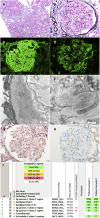The Complexity and Heterogeneity of Monoclonal Immunoglobulin-Associated Renal Diseases
- PMID: 29703839
- PMCID: PMC6050917
- DOI: 10.1681/ASN.2017121319
The Complexity and Heterogeneity of Monoclonal Immunoglobulin-Associated Renal Diseases
Abstract
Monoclonal gammopathies are characterized by the overproduction of monoclonal Ig (MIg) detectable in the serum or urine resulting from a clonal proliferation of plasma cells or B lymphocytes. The underlying hematologic conditions range from malignant neoplasms of plasma cells or B lymphocytes, including multiple myeloma and B-cell lymphoproliferative disorders, to nonmalignant small clonal proliferations. The term MGUS implies presence of an MIg in the setting of a "benign" hematologic condition without renal or other end organ damage. The term MGRS was recently introduced to indicate monoclonal gammopathy with MIg-associated renal disease in the absence of hematologic malignancy. Most MIg-associated renal diseases result from the direct deposition of nephrotoxic MIg or its light- or heavy-chain fragments in various renal tissue compartments. Immunofluorescence microscopy is essential to identify the offending MIg and define its tissue distribution. Mass spectrometry is helpful in difficult cases. Conditions caused by direct tissue deposition of MIg include common disorders, such as cast nephropathy, amyloidosis, and MIg deposition diseases, as well as uncommon disorders, such as immunotactoid glomerulopathy, proliferative GN with MIg deposits, light-chain proximal tubulopathy, and the rare entities of crystal-storing histiocytosis and crystalglobulinemia. Indirect mechanisms of MIg-induced renal disease can cause C3 glomerulopathy or thrombotic microangiopathy without tissue MIg deposits. Treatment of MIg-associated renal disease is aimed at eliminating the clonal plasma cell or B-cell population as appropriate. Both the renal and the underlying hematologic disorders influence the management and prognosis of MIg-associated renal diseases.
Keywords: Renal pathology; kidney disease; multiple myeloma.
Copyright © 2018 by the American Society of Nephrology.
Figures








Comment in
-
Smoldering Myeloma Presenting with Renal Histopathology of Monoclonal Gammopathy of Renal Significance: Adding to the Complexity.J Am Soc Nephrol. 2018 Dec;29(12):2901. doi: 10.1681/ASN.2018080864. Epub 2018 Oct 30. J Am Soc Nephrol. 2018. PMID: 30377233 Free PMC article. No abstract available.
-
Authors' Reply.J Am Soc Nephrol. 2018 Dec;29(12):2902. doi: 10.1681/ASN.2018101003. Epub 2018 Nov 2. J Am Soc Nephrol. 2018. PMID: 30389728 Free PMC article. No abstract available.
References
-
- Kyle RA, Therneau TM, Rajkumar SV, Offord JR, Larson DR, Plevak MF, et al. .: A long-term study of prognosis in monoclonal gammopathy of undetermined significance. N Engl J Med 346: 564–569, 2002 - PubMed
-
- Merlini G, Stone MJ: Dangerous small B-cell clones. Blood 108: 2520–2530, 2006 - PubMed
-
- Rajkumar SV, Dimopoulos MA, Palumbo A, Blade J, Merlini G, Mateos M-V, et al. .: International myeloma working group updated criteria for the diagnosis of multiple myeloma. Lancet Oncol 15: e538–e548, 2014 - PubMed
Publication types
MeSH terms
Substances
Grants and funding
LinkOut - more resources
Full Text Sources
Other Literature Sources
Medical
Research Materials
Miscellaneous

